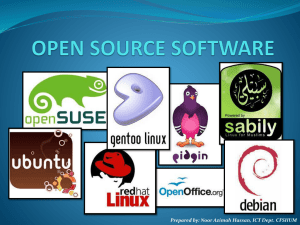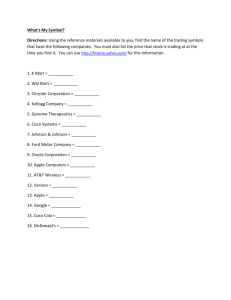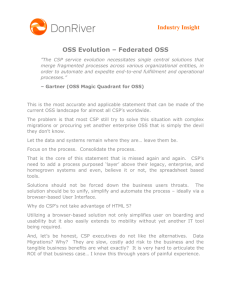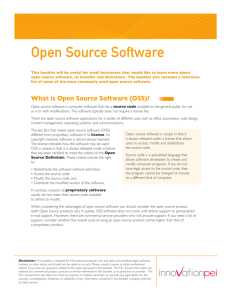oss_healthcare_case_v1
advertisement
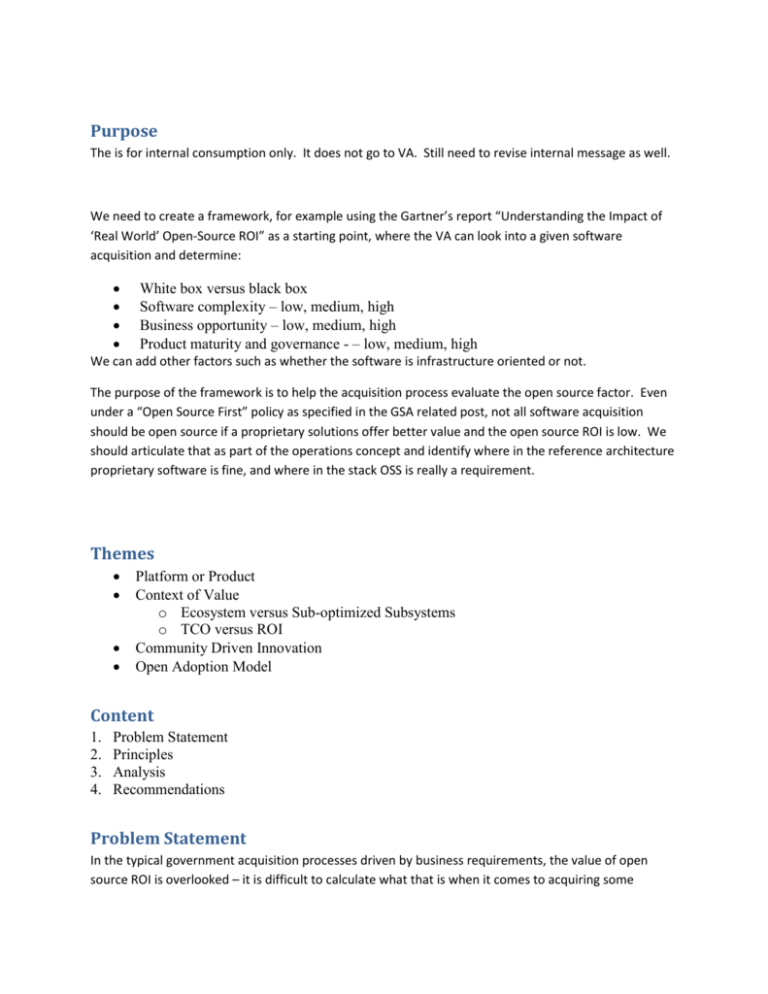
Purpose The is for internal consumption only. It does not go to VA. Still need to revise internal message as well. We need to create a framework, for example using the Gartner’s report “Understanding the Impact of ‘Real World’ Open-Source ROI” as a starting point, where the VA can look into a given software acquisition and determine: White box versus black box Software complexity – low, medium, high Business opportunity – low, medium, high Product maturity and governance - – low, medium, high We can add other factors such as whether the software is infrastructure oriented or not. The purpose of the framework is to help the acquisition process evaluate the open source factor. Even under a “Open Source First” policy as specified in the GSA related post, not all software acquisition should be open source if a proprietary solutions offer better value and the open source ROI is low. We should articulate that as part of the operations concept and identify where in the reference architecture proprietary software is fine, and where in the stack OSS is really a requirement. Themes Platform or Product Context of Value o Ecosystem versus Sub-optimized Subsystems o TCO versus ROI Community Driven Innovation Open Adoption Model Content 1. 2. 3. 4. Problem Statement Principles Analysis Recommendations Problem Statement In the typical government acquisition processes driven by business requirements, the value of open source ROI is overlooked – it is difficult to calculate what that is when it comes to acquiring some software. For example, we have often heard the statement from VA that the business requirements do not say that the software to be developed needs to take consideration of working with open source community to allow for bi-directional code intake. But if you don’t participate in the open source community, you lose the value of the higher ROI that come with code innovation. We also hear that the open source software need to be competitive in value or TCO when comparing with proprietary solutions; however, TCO in isolation does not address whether it is a type of software that can reap future ROI through mature open source community contributions that drive development. Of course, bi-directional code intake is necessary for this as well. But it understanding the full value requires taking into account new value and innovation as part of ROI and not just cost. In addition to the bi-directional code intake necessary for a mature community to drive ROI, we need to establish the context of value. OSEHRA as an ecosystem seeks to extend and preserve the value of traditional M based VistA as part a larger open healthcare platform. There are other IT pieces that need to be part of such a platform, and those pieces need to be consistent with an open architecture that extends the reach of VistA to all stakeholders. An example of this is infrastructure oriented software such as an ESB. In order for new modules to be easily tested and evaluated by the community, the open healthcare platform core needs to be available to everyone and to have no barriers to entry. This points towards open source IT infrastructure as an enabler for healthcare IT. Principles 1. 2. 3. 4. What is the context of value? VA or Healthcare Community What are / should we measure? ROI or TCO? Are we applying OSS to the Platform or to a Product? What OSS business models are a fit for the VA and for the Community? Open Adoption 4.1. What structures encourage a Culture of Community? Stable policy, long term commitment, follow-through, steady velocity, transparency, clear and stable path to market for all stakeholders. 4.2. What structures discourage a Culture of Community? Policy confusion, fragmenting the resources of the community, instability in the path forward 4.3. What technical structures enable the community to collaborate efficiently? Infrastructure-as-Code 5. Which elements of the Platform require an OSS model? 5.1. VistA is the core of the platform. 5.2. Other elements of the Platform seek to provide a pluggable infrastructure around VistA to extend the reach of domain specific value in VistA by addressing IT concerns such as scalability, security, and operations. 5.3. Both domain (VistA) and IT concerns must be addressed in an open manner by the Platform in order to deliver a Solution. 5.4. OSEHRA provides a collaborative environment based on infrastructure-as-code principles where the community can contribute to both VistA and the IT concerns of the platform. 5.5. Components on the edge can be proprietary, e.g. a scheduling or even a lab system that supports open standards for communication, assuming there is sufficient stability and maturity in the Platform to provide modularity, and assuming that they are still publicly available for testing and integration. 5.6. The platform core integration core that links modules together into a solution have to be publicly available and stable so that Stakeholders have confidence that their investment will be protected. 5.7. Different strategies for service enabling VistA are viable, e.g. EWD, VSA. These can be managed by a Reference Architecture. 5.8. The platform core should have an OSS Reference Implementation to ensure that all stakeholders have a path forward. Assuring broad participation provides the economies of scale for both economics but also innovation. 5.9. None of this works if the principle stakeholder in OSEHRA, the VA, fragments adoption by using proprietary infrastructure at the platform core. Analysis 6. ROI Framework 7. Value Analysis 7.1. Standards and Standardization 7.2. Integration Enables Innovation 7.3. Community Driven Innovation 7.4. Accelerating Commoditization 7.4.1. How far has OSS commoditization curve moved up the technology stack? 7.4.2. How far has OSS commoditization moved up the healthcare stack? 8. TCO Analysis 8.1. Commercially Supported OSS 8.2. Cost of Access 8.3. Cost of Exit 8.4. Competition 8.5. Cost and Risk Sharing 8.5.1. OpenStack VA Recommendations Open Adoption Model API Management Infrastructure-as-code OSS Reference Implementation OSEHRA Recommendations This is just a section that will not be in the whitepaper itself, but is a placeholder to remind us to extract lessons learned and perhaps consider what we as a community can do to drive adoption and innovation rather than wait for the VA. We currently are bottlenecked by the VA in terms of accepting community contributions. What can we do to accelerate or change that? Is it a given that the VA should own this process and be the rate controlling element?


